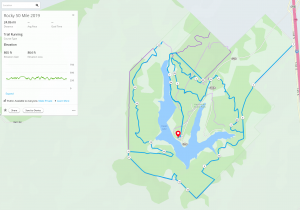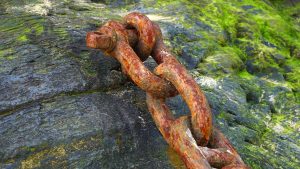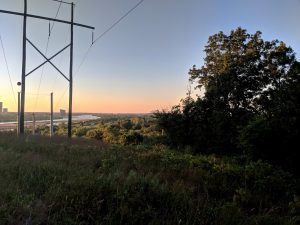The sport of ultra marathoning, i.e. by technical and literal definition any race that is longer than the established 26.2(ish) miles of a marathon, has grown quite rapidly. In no small part it’s my firm belief because let’s face it these it’s a little cooler to say “I’m going to be running my first [50K, 50Mile, 100K, 100Mile] that there are a greater number of people who are attempting these distances.
But after purchasing and reading multiple books on the subject of ultra marathoning I find there is lack of information for folks like myself. The published training plans are aimed at doing well in ultra marathons. At finishing in the front pack, not the mid or back pack.
And a 100 mile ultra is yet another step toward my goal to see how far I can go before I break in the trying.
Websites with how to run your first 100 mile have anecdotes like “marathon time of sub 4” which frankly for a lot of us isn’t even a dream. You can train for endurance, anyone barring physical disabilities can train to ‘go long’. But to go fast requires a certain amount of physical ability. To endure a 100 mile race that does not include a high level of vertical and technical terrain and do it in under the typical 30 hour cut off only requires an average of 18 minute miles. A fair number of people, not me, can sustain somewhat easily a sub 18 minute walk. Me, my walk pace is closer to 19 minutes. So for me to do a 100 mile in the 30 hour cut off I have to run some portion of it.
For us mere mortals let’s ‘do the math’ and see what we have to accomplish in order to finish a 100 mile race purely from a moving pace perspective. I think it’s not as bad as you might be assuming if you’re just looking into the crazy notion of moving 100 miles without stopping.
For me, let’s choose a moderate pace assuming some levels of moderate vertical and technical terrain. A 6 minute run at 12:00m miles and a 4 minute walk at 20:00m miles is an average of 14:17 minute miles. That’s a sub 24h 100 mile. Granted that’s not possible for anyone to actually be able to finish at as there’s no AS breaks, potty breaks, food breaks, scenery appreciation breaks etc. But still that leaves 6 hours for all the breaks. (Again assuming a 30 hour cut off)
Drop the run pace a small touch so you average 15:00m pacing and you still have yourself a 25hour 100 mile. Based on a 6/4 run/walk schedule that’s a 12:52 run pace and a 20:00 walk pace.
Which oddly enough a 12:52 is exactly my average pace for the very first 5K I did 2 years ago this month.
So for those of us who merely desire to do the distance these numbers should be of some at least small inspiration in that yes we too can aspire to completing an ultra marathon of even the bigger distances.
Many of the books and online guidance do have it right I believe, an Ultra, especially once you get past the 50k distance is going to be a combination of two factors. Time on feet because our bodies, especially our feet, have to be prepared to be upright and mobile for these increased time frames. And mental endurance to sustain the discomfort, boredom, fatigue that our minds will suffer from being upright and mobile. These are both very much trainable.
My ability to do boring things for extended lengths of time has greatly increased thanks to our long runs. I can sit through 2 hours of kids choir concerts a lot easier now than I could 3 years ago. You learn/gain the ability to speed the passage of time, an analog mode organic based time machine if you will. While it passes at the same inexorable rate it always does, you no longer are part of ever tick. Think of it like using an Acceleration Wand in Minecraft, except in reverse. You’re decreasing your own ‘tick rate’ so that the world speeds up in relation to you rather than speeding you up in relation to the world.
 Time on feet becomes more and more important in my opinion the larger a runner you are. Yes I speak from personal and painful experience.
Time on feet becomes more and more important in my opinion the larger a runner you are. Yes I speak from personal and painful experience.
It’s quite simple, more weight equals more impact because gravity is a bitch. More impact is more stress. So the larger you are the harder on your feet and every impact absorbing component of your body it is. This physical stress is a lot more difficult to remediate. You can ‘will’ it away to some extent and medicate it away to a larger degree but the human machine that you are does have a point of failure. I recently hit that this last weekend in fact where I started cramping bad from pushing things too hard over the course of a long day in my calves and shins.
Mental stress has more available remediation. Simply finding someone else on the trail and hanging with them if they’re amenable can be a major boost for most runners although it’s my observation that ultra running tends to be a solitary sport to a larger degree than street running. Listening to audio of some kind, music, podcasts, books on tape can also help. Or simply zoning out of everything but your focus on where you’re going to place your next 10 steps. Just don’t zone out in general as that’s the fastest way to take a dirt nap.
In terms of training most, even perhaps all, of the plans available on the internet are created by and aimed at front packers. Front packers are just literally the folks who will finish at the front of the pack. They’re the ones who have the physical and mental resources to travel 100 miles in under 20 hours, in most cases well under 20 hours.
These leaves a gap for those without their level of abilities, i.e. the mere mortals. When we try to do their training plans we end up injured, burned out or find out we can’t hit those 70-80 mile weeks and those 30+25 back to back weekends that we simply cannot do an ultra marathon. And I believe that couldn’t be further from reality.
It makes for an easy rationalization to pull back to the safe distances we’ve done and if we need that rationalization / opt-out then there’s nothing inherently wrong with that. You do you as the saying goes. But you’ll never know how far you could have gone if you don’t push yourself.
If you’re still with me then I think as long as you can achieve the following with an average pace of under 17 minute miles including all breaks and recoveries then you can be an Ultra Marathoner. Granted for the typical cut off times you just need to average 18 minutes but realistically you need to allow for a little slack for unexpected events, terrain etc that might cost you some time so I feel an average pace of 17 is a good value to shoot for as your upper edge-
- 50K – 3-4 weeks prior to the race having done 20-26 mile long run.
- 50Mile – 3-4 weeks prior to the race having done 30 mile long run.
- 100K – 3-4 weeks prior to the race having done 30 mile long run.
- 100M – 4-6 weeks prior to the race having done 50 mile long run.
Is this a very simplistic rule of thumb? Yes of course it is. It’s yet another one size fits all kind of blanket statement.
Now to get to the above long run goals then you need to build your training plan based on your own abilities. The “I’m an elite and this training plan is how I train” plans are unlikely to work for most of us, at least in the early years, especially the first year.
You can obviously pay to play and hire a trainer and there’s certainly value in having an experienced open minded trainer helping chart your path to your first or 100th ultra marathon. Unless you live in a small town it’s likely there are plenty of runners out there in your area who can offer thoughts and recommendations on trainers.
If you’re going to roll your own plan then take any online plan with a big dose of salt and skepticism. Unless the author goes at length to indicate it’s aimed at someone of your current ability then assume it’s going to be a good plan for the upper 25% of ultra runners. If you fall into that category then no issue but if you might not be there yet then I’ll offer the following recommendations based on my own experiences. Much like every other plan and guidance out there come at it with salty skepticism that it will work for you (this assumes you have at least the ability to do a 20 mile long day). If you can’t do that much yet then jump on any of the 3 to 4 day week, 4 month marathon training plans out there. You don’t have to race the marathon, just have the ability to do the distance –
- dial back the weekly mileage to something manageable (you’ll have to judge this for yourself but a reasonable guidance might be start with 20 miles a week and peak at 50 not withstanding the race week in #10 below)
- have at least half the weeks with 3 or 4 runs instead of 5 or 6 and potentially average 4 workouts a week.
- weekday runs should in general be speed runs (400’s/800’s, thresholds, intervals etc) to improve your VO2 max and running efficiency.
- restrict your double long run / back to back weekends to 2 per month
- do not increase your total mileage per week by more than 10%
- do not have a long run more than 30 miles in general, exception one 50 mile long run a few weeks out if you’re doing a 100 mile race.
- do not have a back to back weekend of more than 50 miles
- do not have a same day back to back runs of more than 30 miles
- one recovery/light week a month at the start of the plan with one recovery week every 3 weeks as you hit your peak mileage.
- Add in a race if you can manage it in that 3-6 week time frame of a lower distance before your target race. So a marathon before a 50k, a 50k before a 50 mile/100k, a 50 mile before a 100 mile.
After the last year of training to move from a half marathon to something bigger these are my personal truths based on my own abilities right now. I’m a 27m 5k, 60m 10k, 2:15 half, 5:30 full runner. I’m 6-3 and currently 238 lbs as of this morning.
And a 100 mile Ultra is yet another step toward my goal to see how far I can go before I break in the trying.



 Time on feet becomes more and more important in my opinion the larger a runner you are. Yes I speak from personal and painful experience.
Time on feet becomes more and more important in my opinion the larger a runner you are. Yes I speak from personal and painful experience. I’ve been reading race reports of 50+ races and last night I read one that was filled with ‘do not do this’ kinds of events. The runner started out well but then a litany of things went wrong leading to a decision about 2/3rds of the way of whether to even try to finish or not. Much less placing like the runner had planned on at the start of the race.
I’ve been reading race reports of 50+ races and last night I read one that was filled with ‘do not do this’ kinds of events. The runner started out well but then a litany of things went wrong leading to a decision about 2/3rds of the way of whether to even try to finish or not. Much less placing like the runner had planned on at the start of the race. While ginger is a great thing for both runners and #notarunner s alike and has many benefits I’m actually referring to another ginger right now.
While ginger is a great thing for both runners and #notarunner s alike and has many benefits I’m actually referring to another ginger right now. “To the pain…” is such a great quote don’t you think? From a movie filled with great quotes. “To the pain and beyond” is how I deal with running. I was having a talk today with someone who runs 3 to 5 miles and she says after mile 1 and until that last mile running is fun for her. I had to acknowledge it’s not quite that way for me.
“To the pain…” is such a great quote don’t you think? From a movie filled with great quotes. “To the pain and beyond” is how I deal with running. I was having a talk today with someone who runs 3 to 5 miles and she says after mile 1 and until that last mile running is fun for her. I had to acknowledge it’s not quite that way for me.

 “run off the crazy”. On those day’s Trex is more like my very own #luckdragon helping to pulling me out of my emotional storm by the sound of his steady rhythmic pace, his friendly optimism, and his calm demeanor. I count myself lucky to have such a running companion.
“run off the crazy”. On those day’s Trex is more like my very own #luckdragon helping to pulling me out of my emotional storm by the sound of his steady rhythmic pace, his friendly optimism, and his calm demeanor. I count myself lucky to have such a running companion.

